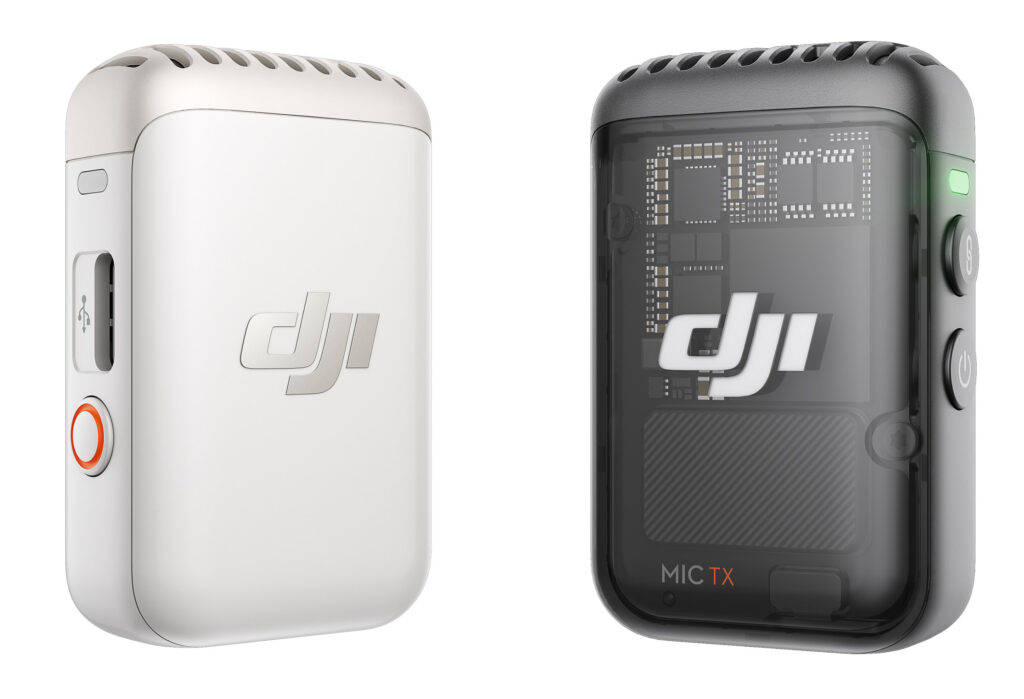Following a cameo appearance in the Osmo Pocket 3 camera, DJI’s Mic 2 wireless microphone system is officially here with some nice upgrades over its popular predecessor. It now connects directly to your smartphone via Bluetooth while also offering improved internal recording quality, AI noise reduction, a larger touch screen, easier controls, and more.
The transmitter comes in gray with a new transparent design, and DJI is also introducing a white option. They’re slightly smaller than before, but very similar to their predecessors, with a clip, magnetic mount, and 3.5mm microphone input. The power and link buttons are now on the same side and are round instead of oval, with the record button and USB-C input on the other side.
One welcome change is that DJI has moved the power-on LED to the sides, rather than closer to the front where it would appear annoyingly on the camera. The DJI logo is front and center, though, so you’ll still need a piece of black tape to cover it.
The receiver has undergone major changes, with a larger 1.1-inch touch screen and a new thumbwheel to make adjustments easier. DJI makes it easy to connect the transmitter directly to your phone, or via the included USB-C and Lightning adapter.
One of the great advantages of the Mic 2 compared to other kits like the Rode wireless Go 2 is the charging case that is sold with the two transmitter kit. A single charge now supports up to 18 hours of use, up from 15 hours before, and the transmitter’s use time has also been upgraded from 5.5 hours to 6 hours.
The most important new feature is direct Bluetooth connection support, allowing you to pair the transmitter mic with your phone (or DJI’s Osmo Pocket 3 and Action Cam 4) without the need for a receiver. This will allow creators on a budget to purchase the transmitter mic alone for $99, or add DJI’s lavalier mic for an additional $35.
Connecting your phone is relatively easy – press and hold the record button for three seconds to put it into Bluetooth mode, then press and hold the connect button for two seconds. From there, your phone should detect the transmitter. It works great with my Pixel 7a, even though it’s not on the approved list, and I was able to start recording videos with better quality audio, to say the least.
There are some caveats: the AI noise cancellation feature doesn’t work when connected to a smartphone, and you can only use one transmitter at a time. However, if you have a transmitter/receiver combo, you can also get audio by connecting the receiver directly to your phone as before.
Speaking of which, the Mic 2 has some improvements in audio quality. It promises “brighter, more natural sound” for interviews or stand-up work where it’s primarily used. While the original DJI microphone supported internal recording as a backup to the camera file, it now captures recordings at higher 32-bit floating point quality, allowing you to maximize gain without worrying about distortion. It also supports a higher acoustic overload point (AOP), increased from 114 dB to 120 dB, which means you’ll see less distortion at higher audio levels.
Another quality trick is AI noise reduction, which allows the Mic 2 to reduce ambient noise and make vocals stand out more. DJI promises that it can work in “complex and noisy environments, such as streets and restaurants.”
A full review is coming soon, but I tried the Mic 2 in a variety of situations, including in a car, on a bike, and in the howling wind. It performs well in almost all of these situations, with all distracting noise in car and bike shots blocked out, leaving just a few pleasant ambient sounds. However, even with the included windshield installed, it couldn’t stop the 30-40 mph straight winds over the dunes. Still, it was effective enough that I was able to take this photo, which is impressive.
Key features carried over from the previous model include a safe track option that records at -6 dB lower (in case you accidentally destroy the levels), 820 feet of range for the transmitter/receiver combination (524 feet in the EU) per transmitter Both have a magnetic clip and a sleeve. For the receiver, DJI also provides preset gains for different cameras so that it works relatively well out of the box. It doesn’t include all the latest cameras, so hopefully a firmware update will fix that.
With new options, notably smartphone Bluetooth connectivity and Osmo Pocket 3/Action 4 support, the Mic 2 may once again strike a chord with creators. Right now, two transmitters, a receiver, and charging case are available for $349, a transmitter and receiver are $219, and a single transmitter is $99. You can also purchase the charging case separately for $69.
This article originally appeared on Engadget at https://www.engadget.com/djis-mic-2-now-records-high-quality-audio-to-your-smartphone-via-bluetooth-130018964.html?src =rss
Source link
